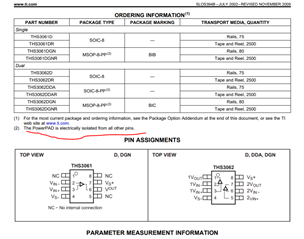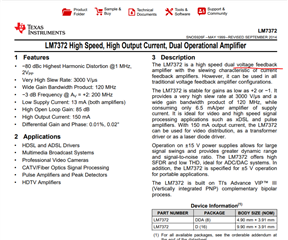Other Parts Discussed in Thread: LM7372, LM2679, LM2673
On one of the circuits that I built, I used the LM7372MRX Op-Amp, a dual, high-speed op-amp in the 8-pin DDA package. According to the datasheet on section 5 page 3 under Pin Configuration and Functions, the exposed pad should be tied to ether V- or left electrically floating. Since they said that the die attach material is conductive and internally tied to V-, I connected it to V- on my PCB.
Now, as a test, I want to try and use a different op-amp. As the title suggests, I want to try and use the THS3062 DDA package. My concern is with the exposed pad on the THS3062. According to the datasheet on page 3, the PowerPAD is electrically isolated from all other pins. Considering how it is electrically isolated from other pins, would it be safe to solder the THS3062's PowerPAD onto a pad that is tied to V- on my PCB? Will it harm anything in my design? I am only doing this as a test so I would like to try and not have to make a new PCB just to test this op-amp.
If it helps, my power supply is +10 volts and -10 volts. The THS3062 will run off of this split supply, and we're only driving small-signals at 100 mV peak to peak. This isn't used for any high-power devices.



